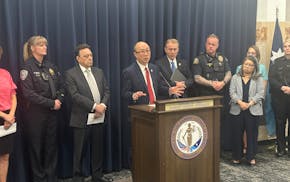Minnesota's once-robust ranks of volunteers who advocate for abused and neglected children have plummeted — and may soon disappear altogether.
The state's sharp shift away from unpaid guardians ad litem makes it a national outlier and has riled volunteers and their supporters, who fear the move could harm kids.
The State Guardian ad Litem Board is expected to decide Tuesday whether to let the program fade as the 25 remaining volunteers eventually quit. Some board members say the increasing complexity of child protection cases and concerns about data security and supervision require the change to a paid employee-only program.
"We don't have volunteers prosecuting. We don't have volunteers doing public defense," said Crysta Parkin, Guardian ad Litem Board chair, who works as an assistant Dodge County attorney. Guardians ad litem have an important job, she said, "I think it's hard to see it as a volunteer role anymore."
A guardian ad litem, whether a volunteer or an employee, conducts investigations into a child's life. They observe and talk to families and review records and reports. They make recommendations to the court about the best options to meet a kid's needs, and monitor court-ordered plans to make sure the child's interests are served.
The potential change comes as Minnesota's child protection system faces renewed scrutiny. A recent Star Tribune investigation showed Minnesota's system has failed to protect hundreds of children from repeat abuse or death.
Volunteers said if the state cuts them out of the court process there will be less transparency and fewer outside perspectives on how to improve outcomes for children, and institutional knowledge and longstanding relationships with kids will be lost.
Minnesota Supreme Court Justice Anne McKeig said she worries there might not be sufficient funding to support the needed paid guardians ad litem if the volunteer program ends.
"We need more guardians, not fewer," McKeig said. "Whenever we make a change like this, even with the best of intentions, there's a possibility it could have unintended consequences — and if it does, vulnerable children and families will pay. That is unacceptable."
A clash over how best to serve kids
Every state except North Dakota has communities that use court-appointed volunteers or a hybrid of volunteers and paid workers.
Minnesota has long relied on hundreds of guardians ad litem volunteers in Hennepin and Ramsey counties. That volunteer roster dwindled as the state officials stopped training them during the COVID-19 pandemic and chose not to restart training.
Child protection cases involve more confidential records related to mental health and drug addiction than they used to, and volunteers' access to that information poses potential security risks, said Parkin and other officials with the state's guardian ad litem program. They said supervision of volunteers has long been insufficient and it would not be cost-effective to adequately supervise the legion of volunteers Minnesota once had.
Volunteers, some of whom declined to be named for fear of retribution from guardian ad litem program officials, said they receive the same training as paid workers and the state could update its technology to ensure private information remains secure.
Paid guardians ad litem juggle an average of 24 cases at a time, said Tami Baker-Olson, program administrator. The majority of children in Minnesota have an advocate, she said, noting that guardians weren't able to serve every child even when they had hundreds of volunteers.
Minnesota increased spending on the program several years ago — about $24 million is devoted to it this year — and has sufficient funding for a paid workforce of guardians, Baker-Olson said. Staff departures are to blame when a kid doesn't have an advocate, she said, and the solution is refilling the position, not using volunteers.
Meanwhile, there is a queue of about 200 potential volunteers who want to receive training, said Gerard Bodell, president of the board of Court Appointed Special Advocates (CASA) Minnesota, which supports the volunteers. He questioned why the state would do away with aid to alleviate employee caseloads.
"They can't fill all their positions and they have high turnover," Bodell said. "It seems inconceivable that the program is pursuing this strategy at a time when the labor market situation is what it is."
The unpaid advocates, often retirees, come from a range of backgrounds: teachers, therapists, attorneys and even corporate executives. They tend to stick in the role longer than paid workers, Bodell said, with the average volunteer tenure nearly nine years.
Volunteers said they generally work with just one or two families and are able to spend more time with the kids because they have fewer cases.
Guardians ad litem are expected to meet with kids once a month.
Bodell, who volunteers on Hennepin County court cases, said he has driven more than an hour to visit kids who are in prison or living in group homes or with relatives. He questioned whether paid employees are able to meet with 20 to 30 families a month and whether those visits are "basically a drive by, or is it a quality visit?"
Parkin said just because volunteers are able to spend hours with kids doesn't mean that's always the right thing to do.
"The role of a guardian is to go in and conduct an independent investigation in the least intrusive manner possible for this child and family," Parkin said. "If what you want to have is a personal, mentoring 'big brother, big sister' role — you know, helping some kid get to adulthood — there are so many organizations out there that that is their role. That's the organization that you need to be volunteering in."
Minnesota unique in eliminating volunteers
Minnesota's shift away from volunteer guardians ad litem dates back to a 2017 report from the National Center for State Courts, Parkin said. It recommended Minnesota end its extensive use of volunteers, stating, "the overwhelming majority of evidence suggests that a full-employee model would be more efficient, effective, and ensure the long-term sustainability and viability of the Minnesota GAL program."
At the time, the judicial districts that cover Hennepin and Ramsey counties had 378 volunteers. Just 25 volunteers remain.
Back in 2017, there were a total of 42 paid guardians in those districts. That has climbed to 61.
A cost-effectiveness analysis produced last year by a division of Minnesota Management and Budget says the performance of volunteer and paid guardians ad litem are comparable and unpaid advocates offer some cost savings.
However, it adds that the volunteers are "perceived as less consistent" when it comes to sticking to work standards and their legally defined role, and said there are limited options to hold volunteers accountable apart from firing them.
Bodell said the report's depiction of volunteers as less professional is "slander." He said CASA Minnesota plans to lobby legislators to pass a law ensuring volunteers' work continues — something they unsuccessfully attempted last session.
Minnesota was an early adopter of volunteer guardians when the idea spread across the nation about 40 years ago, said Sally Wilson Erny with the National CASA/GAL Association. She's flummoxed by the state's shift away from them and isn't aware of any other place in the nation trying to trim its volunteers.
"Why would you take away a resource from children that has worked so well and that there's a national movement about?" Wilson Erny said.

Charge: Twin Cities woman called sister as boyfriend was 'freaking out' before he killed her

YMCA in central Minnesota to pay $140K to settle claims manager sexually harassed female workers

Minnesota wildfire risk called 'critical' as weather service issues watch

